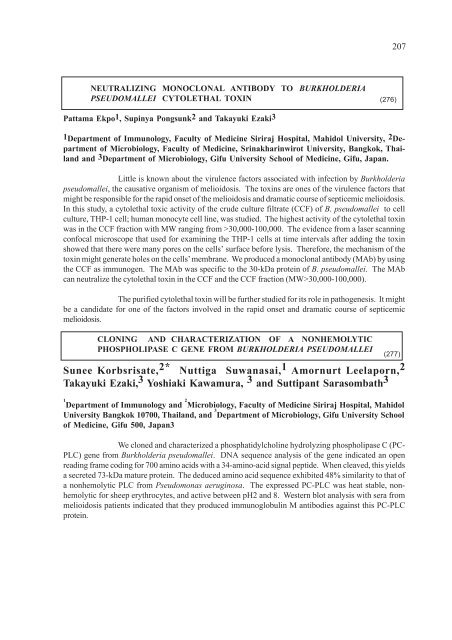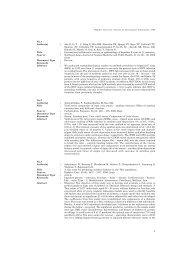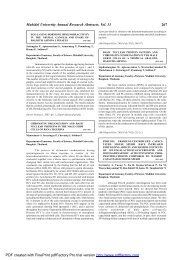THE OSTIA VENAE HEPATICAE AND THE RETHROHEPATIC ...
THE OSTIA VENAE HEPATICAE AND THE RETHROHEPATIC ...
THE OSTIA VENAE HEPATICAE AND THE RETHROHEPATIC ...
Create successful ePaper yourself
Turn your PDF publications into a flip-book with our unique Google optimized e-Paper software.
NEUTRALIZING MONOCLONAL ANTIBODY TO BURKHOLDERIA<br />
PSEUDOMALLEI CYTOLETHAL TOXIN<br />
Pattama Ekpo1, Supinya Pongsunk2 and Takayuki Ezaki3<br />
1Department of Immunology, Faculty of Medicine Siriraj Hospital, Mahidol University, 2Department<br />
of Microbiology, Faculty of Medicine, Srinakharinwirot University, Bangkok, Thailand<br />
and 3Department of Microbiology, Gifu University School of Medicine, Gifu, Japan.<br />
Little is known about the virulence factors associated with infection by Burkholderia<br />
pseudomallei, the causative organism of melioidosis. The toxins are ones of the virulence factors that<br />
might be responsible for the rapid onset of the melioidosis and dramatic course of septicemic melioidosis.<br />
In this study, a cytolethal toxic activity of the crude culture filtrate (CCF) of B. pseudomallei to cell<br />
culture, THP-1 cell; human monocyte cell line, was studied. The highest activity of the cytolethal toxin<br />
was in the CCF fraction with MW ranging from >30,000-100,000. The evidence from a laser scanning<br />
confocal microscope that used for examining the THP-1 cells at time intervals after adding the toxin<br />
showed that there were many pores on the cells’ surface before lysis. Therefore, the mechanism of the<br />
toxin might generate holes on the cells’ membrane. We produced a monoclonal antibody (MAb) by using<br />
the CCF as immunogen. The MAb was specific to the 30-kDa protein of B. pseudomallei. The MAb<br />
can neutralize the cytolethal toxin in the CCF and the CCF fraction (MW>30,000-100,000).<br />
The purified cytolethal toxin will be further studied for its role in pathogenesis. It might<br />
be a candidate for one of the factors involved in the rapid onset and dramatic course of septicemic<br />
melioidosis.<br />
CLONING <strong>AND</strong> CHARACTERIZATION OF A NONHEMOLYTIC<br />
PHOSPHOLIPASE C GENE FROM BURKHOLDERIA PSEUDOMALLEI<br />
Sunee Korbsrisate, 2* Nuttiga Suwanasai, 1 Amornurt Leelaporn, 2<br />
Takayuki Ezaki, 3 Yoshiaki Kawamura, 3 and Suttipant Sarasombath 3<br />
1<br />
Department of Immunology and 2<br />
Microbiology, Faculty of Medicine Siriraj Hospital, Mahidol<br />
University Bangkok 10700, Thailand, and 3<br />
Department of Microbiology, Gifu University School<br />
of Medicine, Gifu 500, Japan3<br />
We cloned and characterized a phosphatidylcholine hydrolyzing phospholipase C (PC-<br />
PLC) gene from Burkholderia pseudomallei. DNA sequence analysis of the gene indicated an open<br />
reading frame coding for 700 amino acids with a 34-amino-acid signal peptide. When cleaved, this yields<br />
a secreted 73-kDa mature protein. The deduced amino acid sequence exhibited 48% similarity to that of<br />
a nonhemolytic PLC from Pseudomonas aeruginosa. The expressed PC-PLC was heat stable, nonhemolytic<br />
for sheep erythrocytes, and active between pH2 and 8. Western blot analysis with sera from<br />
melioidosis patients indicated that they produced immunoglobulin M antibodies against this PC-PLC<br />
protein.<br />
(276)<br />
207<br />
(277)

















